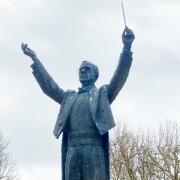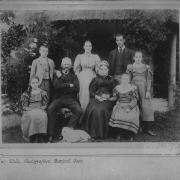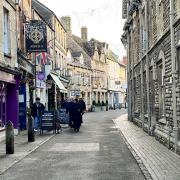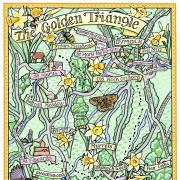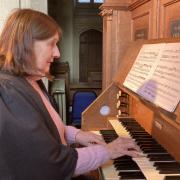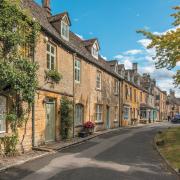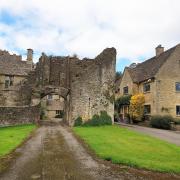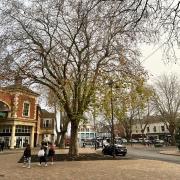Never one to be predictable, Stephen Roberts bypasses Stratford-upon-Avon entirely, and goes in search of the Bard in Gloucestershire... and finds pretty convincing evidence he may have once lived here
I know what you’re thinking. This should be ‘Shakespeare’s Warwickshire’. It certainly could be: The self-styled ‘Bard County’ which I’ve written about twice previously in Shakespearean style. I’ve chosen to buck convention, though, and look at his relationship with Gloucestershire. How much does the county feature in his writing and was he ever here?
I figure that his Histories are a good place to start as they are a caricatured account of what occurred in the reigns of King John, a fairly continuous sweep through Richard II, Henry IV, V and VI, and Richard III, which includes a lively rendition of the Wars of the Roses, and concluding with the irascible Tudor, Henry VIII. If you know your medieval monarchs you’ll realise that he omitted Edward IV (betwixt Henry VI and Richard III) but then all his best bits are contained in Henry VI Part 3 in any case. To be fair, you could easily rename Henry VI Part 3 as Edward IV and no-one would be any the wiser.

There’s a mention of the wilds of Gloucestershire in Richard II. In Act 2 Scene III, the Earl of Northumberland, father to the famous ‘Hotspur’, is in Gloucestershire talking to Henry Bolingbroke, the future Henry IV: ‘Believe me, noble lord, I am a stranger here in Gloucestershire. These high wild hills and rough uneven ways draws out our miles, and makes them wearisome … But I bethink me what a weary way from Ravenspurgh (Ravenspurn, East Riding) to Cotswold will be found’. I suppose, in all fairness, the Earl couldn’t enjoy the benefits of the M5 or its Gloucester services. It must have been a tiresome trek. Not for the first time in the play Berkeley is mentioned: In fact, both Northumberland and Bolingbroke ask: ‘How far is it … to Berkeley?’ Clearly it wasn’t just motorway accoutrements they lacked, but also Sat Navs. Berkeley, of course, was where the denouement of an earlier monarch had occurred; the rather unfortunate Edward II. It’s a pity Shakespeare didn’t write that play too as he would have had a veritable field day with that King’s ‘exit left pursued by a red hot poker’.

There are fictional characters who hail from Gloucestershire, such as Robert Shallow, a wealthy landowner and JP who pops up in Henry IV Part 2 and The Merry Wives of Windsor. Henry IV is an interesting one. Part 1 concludes with the Battle of Shrewsbury (1403) when the King has to fight to defeat a coalition of rebels including ‘Harry Hotspur’ (Sir Henry Percy) who’ll be among the dead. On the King’s side, meanwhile, is Sir John Falstaff. Part 2 picks up the story and includes lots of mentions of Gloucestershire, partly because of Shallow, listed in the ‘Dramatis Personae’ as ‘country Justice’.

Gloucestershire gets its first airing in Act 3 Scene II which is played out ‘before Justice Shallow’s house’ where Mr Shallow reminisces about his time at the Inns of Court, one of his compatriots at the time being ‘Will Squele a Cotsole man’, and yes, you correctly surmised that Squele was a ‘Cotswold man’. He was apparently one of a group of notorious ‘swinge-bucklers’ (bold sparks). The play returns to the county in Act 5 Scene I which takes place in Shallow’s house. Falstaff is there again. In fact, Shallow and Falstaff are perfect protagonists like Mainwaring and Wilson in ‘Dad’s Army’: the rotund, worldly-wise and cunning Falstaff; and the rake-like, vain and rather naïve Shallow, who prefers the provinces (Gloucestershire) to the city (London).

This is when Davy, a servant or factotum to Shallow, mentions ‘William Visor of Woncot’, for it is well attested that Wo’ncot, or Woncot, appears in Henry IV Part 2 (that’s modern Woodmancote, about 3½ miles north of Cheltenham, to you and I). In old English, the name meant ‘woodmen’s cottage’. Davy is looking for some support for Visor: ‘I beseech you, sir, to countenance [support or approve] William Visor of Woncot against Clement Perkes o’ th’ hill’. The jury’s out, though, as the justice retorts with: ‘There is many complaints, Davy, against that Visor. That Visor is an arrant [sic] knave [dishonest or unscrupulous man], on my knowledge’. To be called a knave back then was akin to being labelled a ‘bounder’ or ‘cad’ in Victorian times. It wasn’t a compliment. Woodmancote, meanwhile, is still pronounced ‘Woncot’ and is a place where that Visor, or Vizard, family has flourished, so having an ancestral knave in the dynasty clearly didn’t upset things too much.
Act 5 Scene III, meanwhile, takes place in Gloucestershire again – in Shallow’s orchard. He clearly had a decent pile, with grounds, appropriate for a Justice of the Peace. Falstaff is once again in attendance, among others. If you’re wondering why Falstaff seemed omnipresent in Gloucestershire, forever hanging around Shallow’s place, it was because he was ostensibly in the county on duty, ‘tasked with a recruitment drive’, presumably for the King’s forces. Falstaff was a bit of a knave himself, though, and wasn’t averse to taking a bung to exempt certain, wealthier, people from conscription, so the fighting force he put together tended to be understrength and undernourished.
One of the themes of Henry IV Part 2 is the passage of time and man’s mortality. In Gloucestershire, the land of pippin apples, men discuss the price of sheep and the people who’ve died. I recall my Grandad doing this in rural Herefordshire: Whenever I visited him he regaled me with the latest list of those who’d ‘been in the obituaries’ (as he put it). Whereas London and its Eastcheap tavern is a melting pot, Shakespeare draws Gloucestershire correctly as a county where people are rooted in – and very much identified by – the place where they live, hence Will Squele being identified as a ‘Cotsole man’.

Tewkesbury, of course, has to appear in Henry VI part 3 as Edward IV’s decisive victory at the battle fought there on May 4, 1471 shares with the earlier Battle of Barnet (April 14, 1471) the principal chunk of the play’s final act, Act V, with the Gloucestershire battle taking up Scenes IV and V. It wasn’t easy sticking a fully-fledged battle on the stage, so with Tewkesbury the Bard takes us from Edward and Margaret of Anjou, rallying their respective Yorkist and Lancastrian forces to the struggle’s aftermath with defeated Lancastrians being rounded up. Neat. To be fair, Shakespeare faced lots of battlefield bother in Henry VI Part 3 as there were no fewer than four set-piece battles, more than in any other of his plays. Tewkesbury was bringing up the rear; the fourth of four.
Shakespeare takes liberties with Tewkesbury, arranging a post-battle contretemps between the Yorkist princes (Edward IV; George, Duke of Clarence; and Richard, Duke of Gloucester) and Margaret’s son, the Lancastrian heir, Prince Edward. Young Prince Edward boldly lays into the Yorkists: ‘Lascivious Edward … perjur’d George … misshapen Dick … traitors as ye are; And thou usurp’st my father’s right and mine’. The three Yorkists take it in turn to give the Prince the sharp end of their sword, and Margaret is left wailing for her dead son. Misshapen Dick is already missing come the conclusion of Scene 5 as he’s legging it to the Tower to despatch the Lancastrian king, Henry VI: ‘I’ll hence to London on a serious matter; Ere you come there, be sure to hear some news … The Tower! The Tower!’ Of course, Tewkesbury almost certainly didn’t play out like this.
We don’t know what happened to Prince Edward for sure, only that he died that day. As for Richard, did he really depart Tewkesbury in haste to finish off Henry VI in the Tower? Shakespeare dumps lots of crimes on Richard, his favoured bogey man of the period. There’s any number of Dukes of Gloucester in the plays, but that’s stretching the county connectivity a bit. It does give me the opportunity, however, to mention again one particular Duke of Gloucester, the scallywag who became Richard III and who was very much present and correct at the Battle of Tewkesbury. He’s my favoured historical dinner guest, as I’d love to ask him what he really got up to.

Given that the Bard’s plays include all these mentions of Gloucestershire, is it just possible that he might have lived among us? There’s certainly a story that Shakespeare resided in the county for a while, at Dursley, and thereby acquired his knowledge of the Cotswolds. ‘William Visor of Woncot’ we met earlier: Today’s Woodmancote is a township in the parish of Dursley, which sits at the foot of Stinchcombe Hill. Atop the hill was once a house where a family named Perkis (or Purchas) once lived, which perhaps takes us back to Visor’s protagonist, namely ‘Clement Perkes o’ th’ hill’. The description in Richard II, meanwhile, of the ‘high wild hills’ and the view towards Berkeley (‘there stands the castle by yon tuft of trees’) could well be Stinchcombe Hill and its vista.

Intriguingly, it has been posited that Justice Shallow could be based on Sir Thomas Lucy, a Warwickshire landowner whom Shakespeare fell foul of, leading to him lying low in Gloucestershire for a while. And did those feet in Bardic time? There’s certainly plenty of evidence that there were Shakespeares in Dursley and the surrounding area from the 16th century right through to the 18th, but as for Will himself, well, I leave that up to you to decide.
References
- The Histories (W. Shakespeare / ed. P. Alexander, 1951)
- The Complete Works of William Shakespeare (The Cambridge Text, 1921)
- A Dictionary of British History (Ed. J.P. Kenyon, 1981)
- Shakespeare (I. Brown, 1949)
- The Little Book of Shakespeare (Dorling Kindersley Ltd, 2018)
- Wordnik (www.wordnik.com) – for Woncot.
- Wotton-under-Edge Historical Society (www.wottonheritage.com) – for Dursley story.




